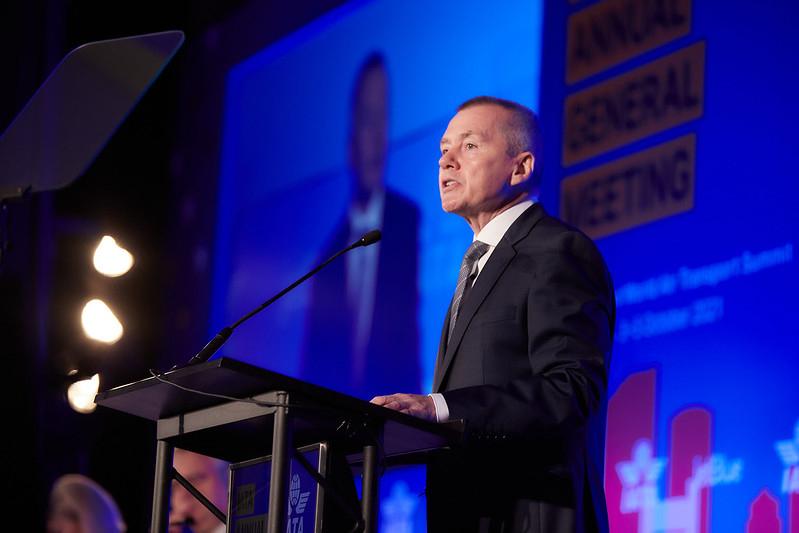
BOSTON—Once the IATA resolution for the global air transport industry to achieve net-zero carbon emissions by 2050 was approved at the organization’s annual general meeting (AGM), it was almost immediately met with the realization of the huge challenges ahead that many delegates agreed would require a step-by-step approach.
“The world’s airlines have taken a momentous decision to ensure that flying is sustainable,” IATA director general and CEO Willie Walsh said Oct. 4, after the resolution was approved. “The post-COVID-19 reconnect will be on a clear path towards net zero. That will ensure the freedom of future generations to sustainably explore, learn, trade, build markets, appreciate cultures and connect with people the world over. With the collective efforts of the entire value chain and supportive government policies, aviation will achieve net zero emissions by 2050.”
Meeting this goal will be a huge challenge, IATA SVP-Environment & Sustainability Sebastian Mikosz said later that day as he laid out the challenge and the plan.
The Challenge
The aviation industry must progressively reduce its emissions while accommodating the growing demand of a world that is eager to fly. “Decarbonizing aviation is a huge challenge,” Mikosz said. “Ten billion passenger journeys will take place in 2050. That means the industry will need to abate 1.8 gigatons of carbon that year.” Moreover, the net zero commitment implies that a cumulative total of 21.2 gigatons of carbon will be abated between now and 2050.
Another “tremendous” challenge Mikosz identified is the ramp up of sustainable aviation fuel (SAF) production from around 100 million liters (26 million gal.) today to around 449 billion liters in 2050.
According to IATA, a key immediate enabler is ICAO’s Carbon Offsetting and Reduction Scheme for International Aviation (CORSIA). “This will stabilize international emissions at 2019 levels in the short- to-medium term. Support for this was reaffirmed in today’s resolution,” IATA said.
The Plan
According to IATA, the strategy is to abate as much CO2 as possible from in-sector solutions such as SAFs, new aircraft technology, more efficient operations and infrastructure, and the development of new zero-emissions energy sources such as electric and hydrogen power. Any emissions that cannot be eliminated at source will be eliminated through out-of-sector options such as carbon capture and storage and credible offsetting schemes.
“We are determined our commitment to net zero is accompanied by a robust plan,” Mikosz said. Achieving net zero will likely involve a combination of measures. “A potential scenario is that 65% of this will be abated through SAFs. We would expect new propulsion technology, such as hydrogen, to take care of another 13%. And efficiency improvements will account for a further 3%. The remainder could be dealt with through carbon capture and storage (11%) and offsets (8%). The actual split, and the trajectory to get there, will depend on what solutions are the most cost-effective at any particular time,” he said.
Delivering on all that will require a huge collective effort from the entire aviation industry and value chain, Mikosz said, including the major oil producers and investors. “Meaningful, practical government assistance will also be essential,” he added.
Collaborations
According to IATA, the resolution demands that all industry stakeholders commit to addressing the environmental impact of their policies, products, and activities with concrete actions and clear timelines, including:
• Fuel-producing companies bringing large scale, cost-competitive SAF to the market;
• Governments and air navigation service providers (ANSPs) eliminating inefficiencies in air traffic management and airspace infrastructure;
• Aircraft and engine manufacturers producing radically more efficient airframe and propulsion technologies; and
• Airport operators providing the needed infrastructure to supply SAF at cost, and in a cost-effective manner.
The Role of Governments
The resolution calls on governments through ICAO to agree to a long-term goal equivalent to the industry’s net-zero-by-2050 commitment. In line with the longstanding approach to managing aviation’s climate change impact, the resolution also called for governments to support CORSIA, coordinate policy measures and avoid a patchwork of regional, national, or local measures.
“Governments must be active partners in achieving net zero by 2050,” Walsh said. “The costs and investment risks are too high otherwise. The focus must be on reducing carbon. Limiting flying with retrograde and punitive taxes would stifle investment and could limit flying to the wealthy. And we have never seen an environment tax actually fund carbon-reducing activities. Incentives are the proven way forward. They solve the problem, create jobs and grow prosperity.”
Milestones
The combination of measures needed to achieve net zero emissions for aviation by 2050 will evolve over the course of the commitment based on the most cost-efficient technology available at any particular point in time.
According to IATA, a base case scenario as follows is the current focus:
2025: With appropriate government policy support, SAF production is expected to reach 7.9 billion liters (2% of total fuel requirement).
2030: SAF production is 23 billion liters (5.2% of total fuel requirement). ANSPs have fully implemented the ICAO Aviation System Block Upgrades and regional programs such as the Single European Sky.
2035: SAF production is 91 billion liters (17% of total fuel requirement). Electric and/or hydrogen aircraft for the regional market (50-100 seats, 30-90 min flights) become available.
2040: SAF production is 229 billion liters (39% of total fuel requirement). Hydrogen aircraft for the short-haul market (100-150 seats, 45-120 min flights) become available.
2045: SAF production is 346 billion liters (54% of total fuel requirement).
2050: SAF production hits 449 billion liters (65% of total fuel requirement).
Scrutiny And Transparency
Walsh said that SAF will fuel the majority of aviation’s global emissions mitigation in 2050. He pointed to the recently announced U.S. Grand Challenge to increase the supply of SAF to 11 billion liters by 2030 as a “great example of the kinds of policies that will drive aviation sustainability. Similarly, the announcements from several big energy suppliers that they intend to produce billions of extra liters of SAF in the near term are welcome. But we cannot tolerate announcements with no follow-up. To be meaningful, fuel suppliers must be accountable for delivering SAF at cost competitive prices.”
Walsh realizes the way forward for all means of carbon mitigation will be scrutinized. “We will match commitments to achievements in reporting that makes it clear how we are progressing,” he said. “Engaging with travelers, environmental NGOs and governments based on transparent reporting will ensure that our flightpath to net zero is fully understood.”





